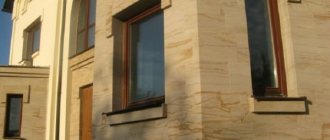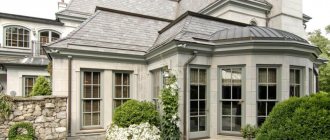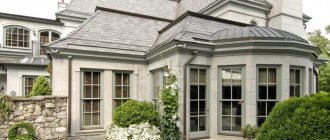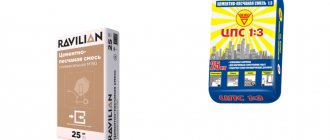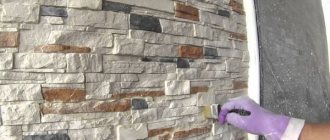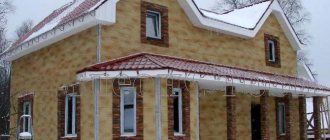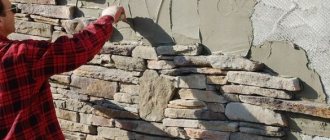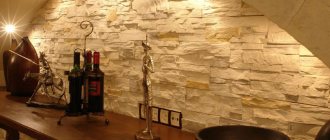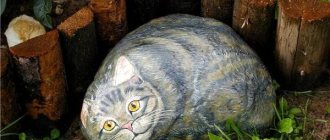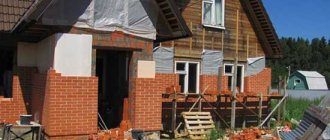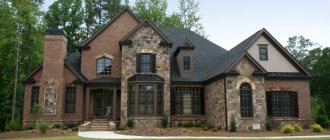The reasons for façade cladding can be different. As a rule, this is to protect the home from moisture and wind, mask significant defects on the main wall, as well as the desire to give the house a more solid and attractive appearance. And sometimes all these reasons can arise at the same time. Often, when choosing a material, the main deciding factor is its complete safety not only for those living in the house, but also for the environment. Dagestan tiles are an ideal solution for those who value quality, durability and environmental friendliness.
Facing the facade of the house with Dagestan stone
Types of Dagestan stone
Dagestan stone is a single name for several materials that can be used to decorate a facade.
This group includes:
Limestone
Limestone is obtained by processing organic residues. This is the most common type of Dagestan tile, characterized primarily by an affordable price.
Shell rock
Shell rock is limestone made from the shells of sea animals. You can clearly see shells of different shapes in the structure. It is also used for finishing fireplaces due to its heat resistance.
Dolomite
Dolomite is a rock that is highly resistant to temperature and fire. It is suitable both for finishing the facade of a house and for cladding retaining walls and basements.
Sandstone
Sandstone is a material obtained by pressing and cementing ordinary sand. It is suitable for making facade decor, finishing tabletops and fireplaces, as well as decorating gazebos.
Facade projects using Dagestan stone
Dagestan stones are born in the bowels of the earth, under the influence of climatic factors.
Over thousands of years they acquire a unique texture. And every layer extracted from the ground or carved out of a mountain range is exceptional. Therefore, there are not and cannot be two identical houses, lined with natural Dagestan stone. Each project is unique. And this is another worthy argument in favor of the material. The aesthetic characteristics of stone make it possible to implement the most interesting design projects for modern houses.
The luxurious mansion is lined with Dagestan stone. The finishing of the plinth is dolomite
A majestic two-story house with a facade and decorative elements made of white Dagestan limestone.
A house decorated with light beige shell rock looks expensive and stylish
House in neoclassical style. The cladding material is sandstone. Decorative elements - limestone
House with marble facade. Even in its modern design, the building resembles a palace
Whatever the idea: to add an accent of luxury to the interior, to emphasize the naturalness and majesty of the exterior, or to add decorativeness to the garden plot, Dagestan stone will help you get an excellent result! Natural stone carries natural beauty, warmth and uniqueness, so choosing this finishing method is the right decision in all respects!
Advantages and disadvantages of the material
In addition to the attractive appearance, the following advantages of using flagstone are highlighted:
- resistance to sudden changes in temperature;
- long service life;
- soundproofing;
- vapor permeability;
- high coefficient of thermal resistance;
- environmental friendliness and, as a result, safety for health;
- ease of installation;
- ease of care;
- variety of colors, textures and shapes.
As for the disadvantages, the following are highlighted:
- high price;
- mandatory treatment of stone with water-repellent impregnations;
- duration of work, since high-quality laying of material on the facade requires patience and accuracy.
Main characteristics
Dagestan tiles are distinguished by high technical performance.
Technical characteristics of Dagestan stone
Of course, when choosing a material for cladding a facade, doubts arise from its weight, which increases the load on the walls.
But with proper installation and the use of high-quality adhesive solutions or durable sheathing, no difficulties arise.
Usage
With the help of Dagestan tiles, you can create spectacular facades that will invariably be stylish and original. Thanks to the wide range of natural stone, it is possible to cladding the entire façade of a building as a whole, as well as to decorate its individual parts.
Balusters. These architectural forms are used to decorate balconies, terraces, porches and steps. They look beautiful and at the same time act as supporting structures, visually reminiscent of small columns. To create balusters, panels made of especially durable Dagestan stone, resistant to static loads, are used.
Sandstone installation options
Installation of Dagestan stone can be done in two ways:
- on metal profiles;
- onto the adhesive solution.
The most common method is on a metal sheathing, since in the case of gluing, sandstone for the facade must have a perfectly flat surface, which in most cases is not typical for it.
Option 1 – on metal profiles
This cladding method has its advantage - the creation of a ventilated facade, which ensures free air circulation between the sandstone layer and the main wall, protecting it from steam penetration.
It includes the following steps:
- Markings are made on the wall to install vertical guides along the facade. Vertical slats should be spaced 60-80 cm apart.
- Using the markings, holes are drilled into which the brackets are mounted with dowels. The distance between them is no more than 50 cm.
- Vertical profile strips are secured using anchors.
- Horizontal guides are reinforced on top. The width between them should be equal to the width of the Dagestan stone.
- The final stage of installation is attaching the stone to the profiles.
Important: if the size of the tiles is different, then the horizontal lathing strips are installed as the layers of stone are laid.
If they are the same size, then to make work easier, all horizontal guides are installed at once.
Option 2 – gluing Dagestan stone to the facade
Finishing the facade with Dagestan stone can be done using a simpler method - using an adhesive solution. It is noteworthy that in the Caucasus this is the most common installation option.
Installation of Dagestan stone with glue
It includes the following steps:
- Plastering the facade to create the most even surface possible.
- Strengthening mesh with small diameter mesh.
- Applying an adhesive layer.
- Installation of Dagestan slabs.
What adhesive mixtures can be used for laying stone
As a rule, medium-sized stones are used in the middle part of the walls of the house, and the smallest of them are used on the sides or at the top, since in this case the facade of the house will look most attractive. The laying work is carried out slowly, and one should not forget about the quality of the masonry mortar, the strength of which directly depends on the strength. Here you can use both traditional sand-cement mortar made from M-150 cement and special adhesive-based mixtures with added plasticizers and other additives.
It is important to take into account that if the weather outside is damp and humid, then to prevent the stones from sliding down, it is recommended to initially apply masonry mortar in the form of a spray or “coat” to the entire surface of the walls and facade, and this can be done with your own hands. However, after such a procedure, laying natural stone can be done no earlier than 2 days, so that the solution has time to adhere well to the wall
In addition, for high reliability of the masonry, a metal mesh is also necessarily used here, which promotes better adhesion of the adhesive mixture to the wall and natural stone. When laying stone in the form of slate, limestone or flat pebbles, a mesh with a cell size of 3-4 cm will be sufficient, but when heavier stones are used - rubble granite or limestone, a mesh with a cell diameter of 5-6 cm should be used. cm.
How to properly prepare walls for laying Dagestan stone
A properly prepared surface is the key to high-quality masonry and an important stage in finishing the facade. If you neglect this measure, there is a risk that the tiles will not stick to the wall and will simply fall off:
- Remove old cladding - paint, plaster.
- Seal holes and cracks.
- Clean all roughness, sagging, and chips.
- Clean the walls from dust;
- Apply plaster in an even layer. The maximum unevenness is no more than 5 mm.
- Treat surfaces with deep-penetrating primer.
Technology for installing metal mesh on the facade of a house
Fiberglass mesh is not suitable for such work. The choice should be made of metal products with small mesh.
- Mesh sheets are prepared in advance. Their length must correspond to the height of the facade.
- Next, holes are drilled for the dowels. Approximately 1 m2 will require 12-17 fasteners. To save money, the Z-shaped fastening method is sometimes used.
- The fastener rod is driven into the hole through the mesh and a nail is attached.
Fastening metal mesh to the facade
How to install stone to the surface
Dagestan tiles must be prepared before installation on the facade. To do this, they are cleaned with a stiff brush, washed from dust and dirt with a soft cotton cloth and dried thoroughly.
The adhesive and grout solutions are mixed according to the instructions. It should be remembered that the amount of compositions is prepared based on 1.5-2 hours of work, since they tend to dry out. Grouting of joints is carried out immediately as the layers are laid out - a feature of façade cladding with sandstone.
After the installation of the mesh is completed and everything necessary for the facade cladding work has been prepared, they begin gluing the Dagestan tiles. To do this, install a starting strip at the bottom of the facade, which is removed upon completion of the finishing work.
- A thick layer of glue is applied to the mesh. It must be completely submerged in the solution. The surface does not need to be leveled - the relief structure, which can be created using a notched trowel, increases the degree of adhesion of the tile to the wall.
- A small amount of glue is also applied to the tile and pressed against the wall, turning it a little.
- To ensure secure fastening, lightly tap the stone with a rubber hammer.
- Excess solution should be removed immediately, otherwise it will be difficult to deal with after drying.
- The next element is laid at a distance of 4-9 mm to form a seam. The grout is pressed between the tiles and the excess is removed.
Cladding with artificial stone
Once the required amount of stone has been manufactured and painted in the desired shades, you can proceed to the next stage - installation. Depending on the planned project, the foundation is faced or the walls are finished outside or inside the house. In the case of an apartment, this could be finishing all the walls with stone or individual sections of them to zone the space. In addition, artificial stone can also perform a household function, being used to make countertops, sinks or kitchen wall panels. In fact, the options for using artificial stone finishing are endless, which provides unlimited possibilities for creating a unique interior.
Artificial stone can be laid on any base, be it brick or plasterboard, wood or metal. The main thing is that the surface is dry and smooth. In some cases, there is a need for additional surface treatment with a primer or adhesive.
Facade cladding with artificial stone
Stone cladding begins with the corner elements. Subsequent elements are laid starting from the top rows, gradually moving down. In this case, even tiles are most often laid in a seamless manner, leaving no gaps between the blocks, and gaps are left between irregular, round-shaped stones, which are filled with mortar.
When facing the foundation, it is important to remember that finishing with stone should be completed at a distance of about 7 cm from the surface of the ground, so that during the cold season the masonry does not freeze and subsequently peel off from the surface of the wall. https://www.youtube.com/embed/zsSGfnVn-SU
Cladding building corners
Cladding the corner elements of the facade with sandstone tiles is much easier if you use special L-shaped strips during the work.
Finishing the corners of a building
They are attached to the wall using brackets and ensure even laying of layers. However, the use of such a design is typical when creating a ventilated facade. As for facing corners when using glue, in this case, they are decorated with various architectural tricks, for example, uneven masonry or the creation of a pseudo-column, where the corner layer of tiles is slightly larger than on the main wall.
Finishing the base and junctions
Facade cladding is not limited to filling flat areas, although even these can be arranged with a high degree of variety. For example, one of the most effective options for using Dagestan stone is dividing a wall into vertical stripes using narrow pilasters and filling the space between them with diagonal masonry with visually embroidered seams. What can we say about the need for proper arrangement of connections at the corners, plinth and under the eaves of the roof.
Finishing with Dagestan stone looks most elegant when contouring the facade with relief elements. Traditionally, external and sometimes internal corners are decorated with rustics. For these purposes, manufacturers supply wide stones, which are laid in vertical strips with a slight indentation if there is no chamfer, or closely if there is one. With straight edges of stones, their joints converging at the corners are formed by an oblique cut.
The connection with the protruding plinth and the final top row are most easily accomplished with straight small-sized elements that form borders when laid horizontally in a sequential manner. Since the size and weight of such stones are somewhat larger than ordinary ones, they need at least a small supporting edge at the bottom so that the element does not slip before the glue sets. In the device for connecting the base, it will be enough to lay out a flat starting plane with plaster and lay the first row of shaped elements. But the final row is laid only after finishing the wall plane, while the upper row elements must first be cut to the required height.
Applying a protective coating to Dagestan stone
Coating tiles made of Dagestan stone with water-repellent solutions does not change its high vapor permeability, and also does not allow the material to absorb excess moisture from the environment. This eliminates problems such as mold, mildew, destruction of tiles and cracks. This stage is carried out upon completion of the façade work, when the glue and grout mixture have completely dried. If you ignore the treatment of the tiles, they may soon darken and lose the attractiveness of their appearance.
Leading manufacturers of flexible stone
When you go to the store to buy a soft product, you can find a large selection presented by different manufacturers. One of them is TPK “Flexible Stone”. Looking through the company's catalogs, one comes across products for facade work, interior cladding, tile materials and roll sheets.
Manufacturers offer products for finishing furnace equipment, bathhouses, saunas, and swimming pools. It is difficult not to notice the frescoes for interior decoration.
The price is high, but it’s worth thinking about the quality, durability, and beauty of the flexible stone. In just a year, you will completely forget about the costs of purchasing coverage.
How is Dagestan stone used in facade decoration?
Using limestone for cladding, unique facades are created that will be distinguished by originality and grace. Thanks to the assortment, you can design both the entire surface of the facade and its individual elements:
- columns;
- balcony;
- arches;
- door and window openings;
- base;
- hanging cornices;
- steps.
Arch lined with stone
Let's sum it up
Facing the facade with Dagestan stone is an ideal solution if you strive not only for the beauty of the appearance of your home, but also care about the strength and durability of the material. In most cases, for work it is preferable to create ventilated structures that will ensure the reliability of the masonry and protect the main wall from moisture penetration and the formation of mold and mildew. Using the material, you can bring to life any design solutions, and by combining stone with other types of finishing, you will certainly be satisfied with the result, which will delight you for many decades.
Differences from other breeds
The first and main difference between Dagestan stone and other rocks is that it is, in fact, not a rock as such, but a group of natural materials used for the exterior (or interior) decoration of houses. Therefore, we can talk about the difference between Dagestan stone and other types only from a general point of view, or consider any one type as a comparison .
An important difference that is mentioned by all sellers and manufacturers is the complete absence of background radiation. Most types of natural stone are quite clearly “phonite”, which cannot but disturb users and reduces the desire to use such material for cladding their home.
There are no complaints about the Dagestan stone in this regard - it is completely clean and does not emit any harmful substances or radiation.
In addition, the special quality, solidity of the cladding, warmth and special aura of the house, decorated with natural ancient stone, stand out.
